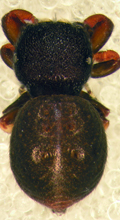Latest News Archive
Please select Category, Year, and then Month to display items
04 August 2020
|
Story Rulanzen Martin
|
Photo Supplied

Dr Nadine Lake, gender studies expert from the Centre for Gender and Africa Studies at the UFS, will participate in a streamed online Facebook discussion on ‘men and masculinities and finding ways of solving conflict and work towards healing the victims, the survivors, the perpetrators.’ This is the 13th episode of the #DigtallyYours discussion series initiated by the embassies of Sweden and the Kingdom of the Netherlands in SA, with support from the European Union in SA. The discussion will be moderated by renowned journalist, Redi Tlhabi.
Other panellists will include Mmatshilo Motsei, S’busiso Malope, Ruben Richards, and Xabiso Vili.
UFS entomologists describe a new spider species
2014-02-19
|
 |
It is about 3mm in size and almost looks like a ladybird, but this new spider is the cause of great excitement at the University of the Free State’s (UFS’s) Department of Zoology and Entomology.
The new species of spider, now known as Rhene amanzi, was recently described for the first time and was ‘introduced’ to other arachnologist at the recent congress of the African Arachnology Society at Amanzi Private Reserve.
Dr Charles Haddad, senior lecturer in the UFS’s Department of Zoology and Entomology, said they already stumbled upon the male spider in 2010 when a student was doing research at the reserve. After a very long process, the spider was described and a couple of weeks ago, whilst at the congress, they also found the female.
“Up to now we only know that the spider lives in trees in the Brandfort area. The range could be wider, but since it was only described recently, other arachnologists will only now be able to identify accurately.”
Dr Haddad says they still have to determine how many eggs the female is able to lay, what the spider’s life cycle looks like and what their habitual preferences are.
“What we do know is that it probably isn’t poisonous and that the spider imitates a ladybird in order to protect itself against predators.”